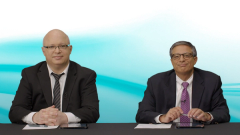
Bispecific Therapies in Multiple Myeloma: Impact on Real-World Practice
Experts share how the availability of three new bispecific therapies has transformed myeloma patient care, offering a lifeline to those previously without treatment options and showcasing positive responses in various patient populations.
Episodes in this series

Transcript:
Sagar Lonial, MD, FACP: Before we start to talk about preemptive management of adverse events and things along those lines, tell me what having 3 of these new bispecifics now available commercially has meant to your practices, because I think to me it’s overnight the light bulb turned on, right? We didn’t have them and then now we do. Just in a few words, what has it meant to your practice?
Luciano Costa, MD: For us it really gave us an outlet in a good way for those patients who need therapies with a mechanism of action other than the PIs, the IMiDs [immune-mediated inflammatory diseases], and the current antibodies, particularly those we couldn’t fit into clinical trials before. So ironically, even though those trials are done without those very specific parameters, most of our early experience are people with poor renal function, preexisting cytopenias, and things like that, people who couldn’t go on a clinical trial or couldn’t even get commercial CAR T chimeric antigen receptor T-cell therapy] before.
I think the positive aspect of that is at least the experience that we have had is they’re fine. They may not have fit the eligibility criteria, but we have really not seen anything that makes it particularly concerning in terms of safety and how they tolerate it. So it really has been really life changing for some of those patients who otherwise didn’t have many therapeutic options.
Sagar Lonial, MD, FACP: So what about at Sinai? What is it…?
Cesar Rodriguez, MD: [What]having these 3 agents available has really given us is that they’re off the shelf, which means that as soon as you see somebody relapsing, you can quickly put them on these agents within a week. It’s really opening the opportunity for all…the patients that we were struggling to treat, or [for whom] we were running out of options [who] we knew would potentially have a meaningful response, that we can now offer them bispecific therapies.
And like Luciano said, a lot of the patients…we’re treating are people who don’t fit the box for a clinical trial because of their renal function or other comorbidities and we’re treating them with these agents and we’re actually seeing that the safety signal is similar. I mean, we’re not seeing something out of the blue that we didn’t see in the clinical trials, which is making us feel even more comfortable using these in people who are sicker, which is good for our patients.
Donna Catamero, NP: And I’ll say that we have 2 different targets. So the potential to sequence is there. [For] patients going back to the real world, what we’re experiencing is the clinical trial data [are] rolling over into patients who are historically not eligible for clinical trials and they’re doing just as well.
Transcript is AI-generated and edited for readability.
Newsletter
Stay up to date on recent advances in the multidisciplinary approach to cancer.









